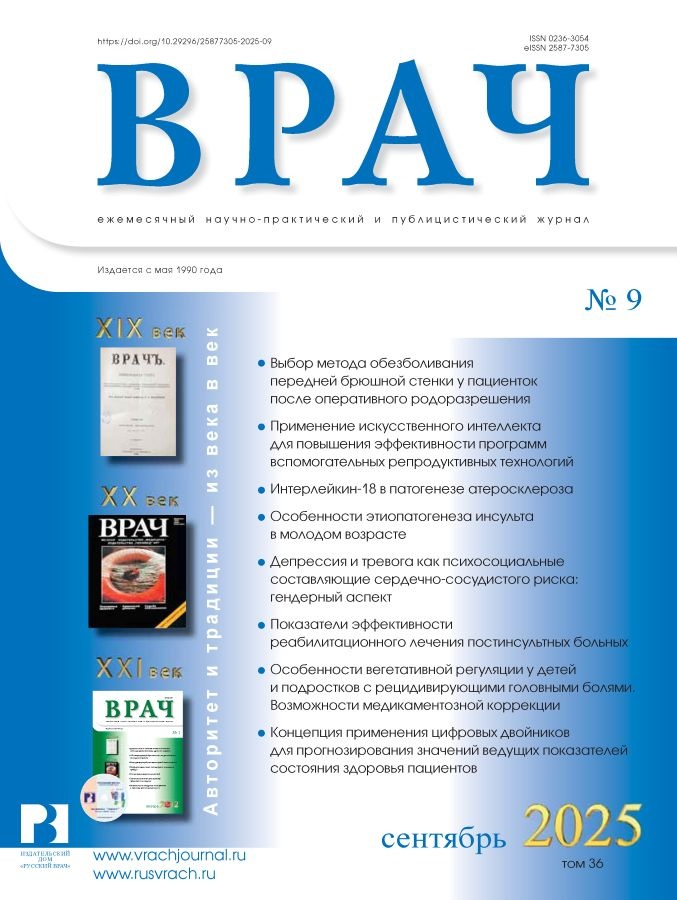The concept of using digital twins to predict the values of leading indicators of patients' condition
- Authors: Grinevich V.B.1, Kryukov Е.V.1, Minakov E.P.2, Seliverstov P.V.1
-
Affiliations:
- S.M. Kirov Military Medical Academy, Ministry of Defense of Russia
- A.F. Mozhaisky Military Aerospace Academy, Ministry of Defense of Russia
- Issue: Vol 36, No 9 (2025)
- Pages: 83-86
- Section: Novelty in Medicine
- URL: https://journals.eco-vector.com/0236-3054/article/view/690600
- DOI: https://doi.org/10.29296/25877305-2025-09-16
- ID: 690600
Cite item
Abstract
The use of digital twins to predict the values of leading indicators of patients' health status, as well as the consequences of events and their outcomes, is one of the most promising areas of modern healthcare. The widespread use of such digital technologies contributes to the modernization of medicine at all stages, which makes it possible to optimize algorithms for diagnosis, treatment, rehabilitation and prevention. This opens a new path to personalized medicine, where the risks of developing diseases and complications are identified long before their clinical manifestation.
Full Text
About the authors
V. B. Grinevich
S.M. Kirov Military Medical Academy, Ministry of Defense of Russia
Email: seliverstov-pv@yandex.ru
ORCID iD: 0000-0002-1095-8787
SPIN-code: 1178-0242
Professor, MD
Russian Federation, Saint PetersburgЕ. V. Kryukov
S.M. Kirov Military Medical Academy, Ministry of Defense of Russia
Email: seliverstov-pv@yandex.ru
ORCID iD: 0000-0002-8396-1936
SPIN-code: 3900-3441
Professor, Academician of the Russian Academy of Sciences, MD
Russian Federation, Saint PetersburgE. P. Minakov
A.F. Mozhaisky Military Aerospace Academy, Ministry of Defense of Russia
Email: seliverstov-pv@yandex.ru
SPIN-code: 4819-0765
Professor, Doctor of Engineering Sciences
Russian Federation, Saint PetersburgP. V. Seliverstov
S.M. Kirov Military Medical Academy, Ministry of Defense of Russia
Author for correspondence.
Email: seliverstov-pv@yandex.ru
ORCID iD: 0000-0001-5623-4226
SPIN-code: 6166-7005
Associate Professor, Candidate of Medical Sciences
Russian Federation, Saint PetersburgReferences
- Garanin A.A., Aydumova O.Y., Kiselev A.R. Digital twins in healthcare administration: A systematic review on novel approaches to management and planning. Russian Open Medical Journal. 2025; 14: e0104. doi: 10.15275/rusomj.2025.0104
- Bagaria N., Laamarti F., Badawi H.F. et al. Health 4.0: Digital twins for health and well-being’. In Connected Health in Smart Cities, ed. A. El Saddik, M. Hossain, and B. Kantarci. Cham: Springer Nature, 2020. doi: 10.1007/978-3-030-27844-1_7
- Sun T., He X., Li Z. Digital twin in healthcare: Recent updates and challenges. Digit Health. 2023; 9: 20552076221149651. doi: 10.1177/20552076221149651
- Селиверстов П.В., Гриневич В.Б., Крюков В.Б. и др. Роль цифровых двойников в терапевтическом сопровождении пациентов. Врач. 2025; 36 (6): 13–9 [Seliverstov P., Grinevich V., Kryukov V. et al. The role of digital doubles in the therapeutic support of patients. Vrach. 2025; 36 (6): 13–9 (in Russ.)]. doi: 10.29296/25877305-2025-06-03
- Прохорова Н.Д., Лебедев Г.С., Прасолов М.С. и др. Применение цифровых двойников в здравоохранении. Менеджер здравоохранения. 2024; 11: 88–96 [Prokhorova N.D., Lebedev G.S., Prasolov M.S. et al. The use of digital twins in healthcare. The health care manager. 2024; 11: 88–96 (in Russ.)]. doi: 10.21045/1811-0185-2024-11-88-96
- Hernandez-Boussard T., Macklin P., Greenspan E.J. et al. Digital twins for predictive oncology will be a paradigm shift for precision cancer care. Nat Med. 2021; 27 (12): 2065–6. doi: 10.1038/s41591-021-01558-5
- Drummond D., Gonsard A. Patient digital twins: an introduction based on a scoping review. medRxiv 2024; 02.20.24303096. doi: 10.1101/2024.02.20.24303096
- Куракова Н.Г., Цветкова Л.А., Полякова Ю.В. Цифровые двойники в хирургии: достижения и ограничения. Хирургия. Журнал им. Н.И. Пирогова. 2022; 5: 97–110 [Kurakova N.G., Tsvetkova L.A., Polyakova Yu.V. Digital twins in surgery: achievements and limitations. Pirogov Russian Journal of Surgery. 2022; 5: 97–110 (in Russ.)]. doi: 10.17116/hirurgia202205197
- Селиверстов П.В., Крюков Е.В., Гриневич В.Б. Практическая реализация технологий искусственного интеллекта при проведении профилактического медицинского осмотра. Медицинский совет. 2025; 13: 266–72 [Seliverstov P.V., Kryukov E.V., Grinevich V.B. Practical implementation of artificial intelligence technologies during preventive medical examination. Medical Council. 2025; 13: 266–72 (in Russ.)]. doi: 10.21518/ms2025-322
- Кобякова О.С., Стародубов В.И., Куракова Н.Г. и др. Цифровые двойники в здравоохранении: оценка технологических и практических перспектив. Вестник РАМН. 2021; 76 (5): 476–87 [Kobyakova O.S., Starodubov V.I., Kurakova N.G. et al. Digital Twins in Healthcare: an Assessment of Technological and Practical Prospects. Annals of the Russian Academy of Medical Sciences. 2021; 76 (5): 476–87 (in Russ)]. doi: 10.15690/vramn1717
- Machado T.M., Berssaneti F.T. Literature review of digital twin in healthcare. Heliyon. 2023; 9 (9): e19390. doi: 10.1016/j.heliyon.2023.e19390
- Khan S., Kandukuri D.K., Subramaniyan E.U. et al. Harnessing the untapped potential of digital twin technology in digital public health interventions. Explor Digit Health Technol. 2023; 1: 11–6. doi: 10.37349/edht.2023.00003
- Aithal P.S. Advances and new research opportunities in quantum computing technology by integrating it with other ICCT underlying technologies. Int J Case Stud Bus IT Educ. 2023; 7: 314–58. doi: 10.47992/IJCSBE.2581.6942.0304
- Björnsson B., Borrebaeck C., Elander N. et al. Digital twins to personalize medicine. Genome Med. 2020; 12: 4. doi: 10.1186/s13073-019-0701-3
- Saratkar S.Y., Langote M., Kumar P. et al Digital twin for personalized medicine development. Front Digit Health. 2025; 7: 1583466. doi: 10.3389/fdgth.2025.1583466
- Селиверстов П.В. Перспективы использования телемедицинских технологий на основе искусственного интеллекта при проведении медицинского осмотра. Медицинский Совет. 2024; 5: 312–9 [Seliverstov P.V. Prospects for the use of telemedicine technologies based on artificial intelligence during medical examination. Medical Council. 2024; 5: 312–9 (in Russ.)]. doi: 10.21518/ms2024-072
Supplementary files







